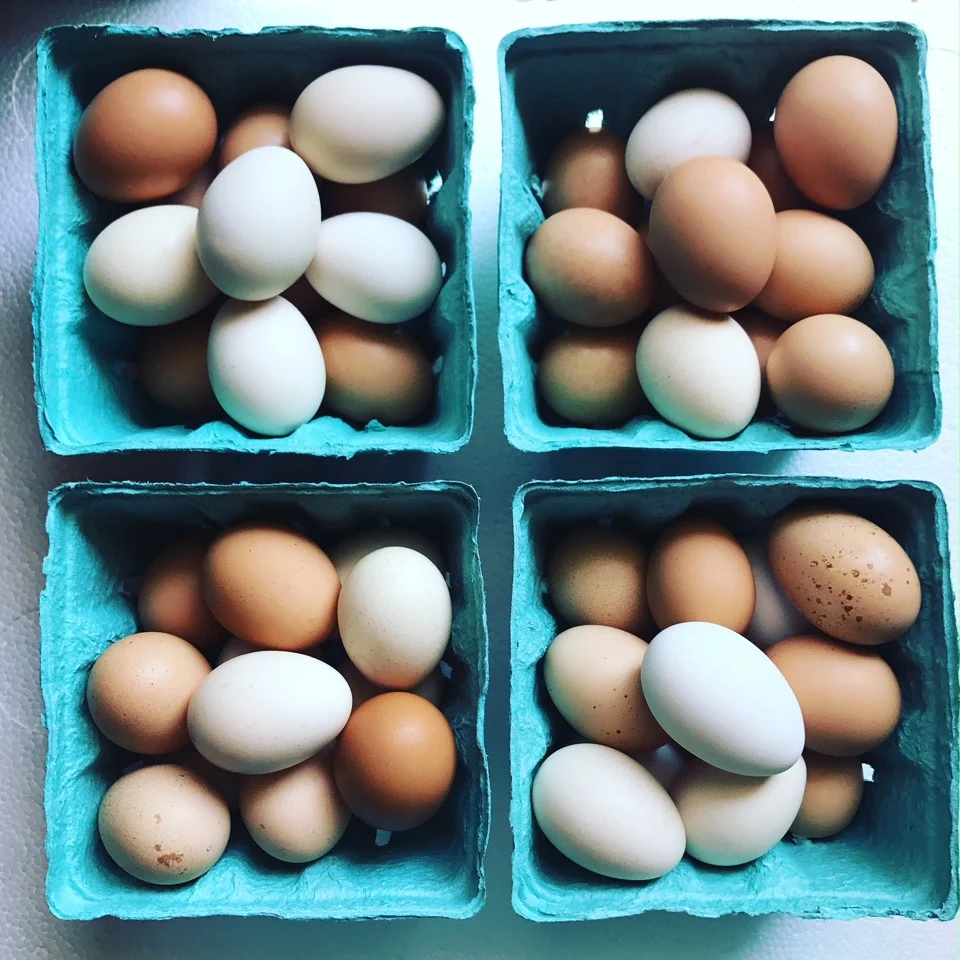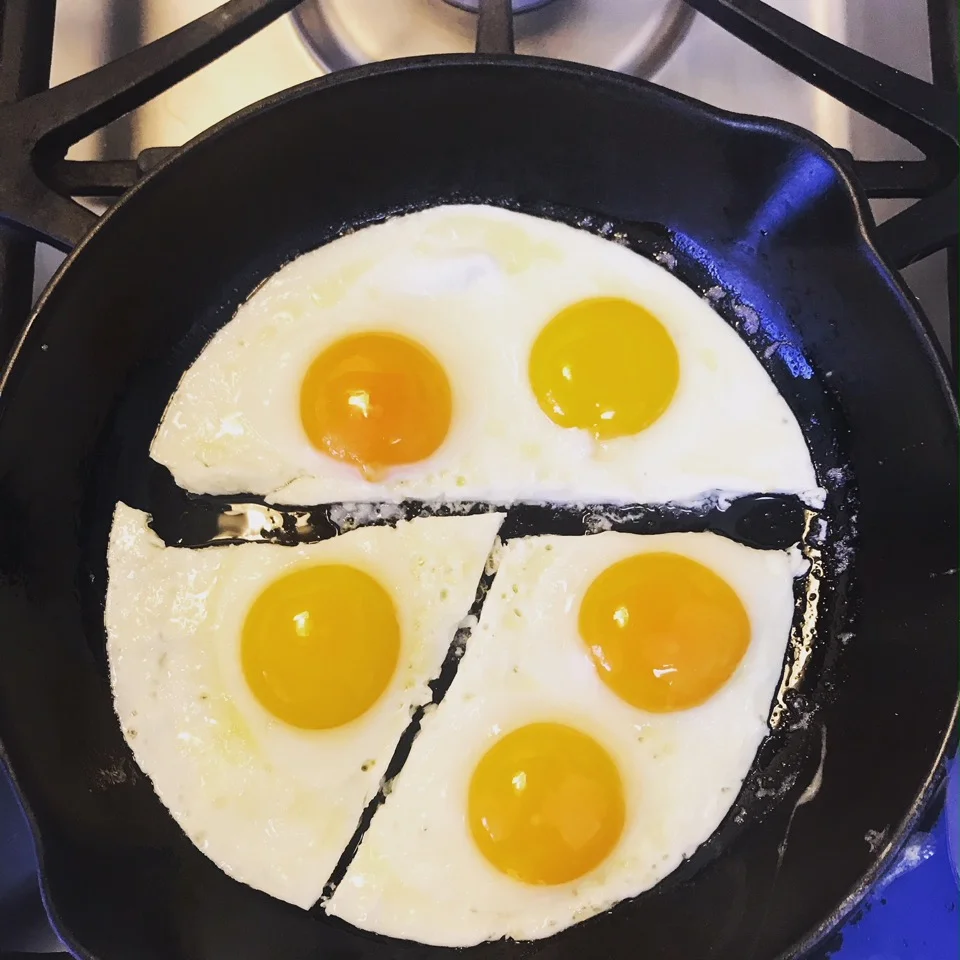Local Ingredients: The Araucana Egg, A Wild Blue Wonder
Writer Luke Shanahan contemplates the virtues of a truly excellent fresh egg with Lloyd Allen of Double L Market.
Consider the egg.
Any serious cook knows its singular importance in the kitchen. Many cooks—serious and novice alike—remember the egg as the first thing they ever learned to cook.
In the book The Next Course, rock-&-roller chef Marco Pierre White, who at 33 became the youngest cook ever to be awarded three Michelin stars, reveals his country side when he suggests that scrambled (gulls) eggs with celery salt served with mayonnaise—an emulsion of egg yolk, acid and oil—may be a worthy last meal on earth. (Here's a handy list of local CT farms that produce fresh eggs.)
If we could go back hundreds of years, we could witness impossibly grand domes forming atop the great cathedrals, their elliptic proportions, cribbed from the humble egg, lending a beauty and structural integrity that would defy gravity for centuries.
Going back to our early human origins, it’s interesting to consider that, just as water is central to the idea of drink, the egg, even back then, may have been central to our idea of food longer than anything else; hunter-gatherers were nicking eggs long before anyone figured out how to make bread.
Going further back, you discover what scientist Dr. Robert Bakker has famously identified as the distant ancestors of modern birds, the dinosaurs, whose eggs might have tasted very much like a chicken egg, transforming the egg on your plate into a kind of paleontological artifact you can eat.
Go back billions of years, to the primordial oceans, and you’ll find a tangle of genetic material professing the first ever declaration of independence, a bold me-not-me expression of individuation, simply by wrapping itself in a semipermeable lipid membrane—a kind of shell forming the skin of a life form now discrete from its environment, which puts to rest the perennial chicken-or-the-egg question (eggs came first).
Symbol of fertility and creation, of the feminine and the masculine, a 3-D model of the divine whose shell, once opened, reveals a quivering tumescent pocket of gold reclining on a raft of luminous translucent white—a visual display of the…very…meaning…of…life!
Plus, you know, who doesn’t love an egg salad sandwich?
You just can’t beat an egg. And yet, you can; they’re that versatile.
But if eggs are so central to the experience of cooking and eating, why aren’t we more selective when it comes to buying them? Why don’t we treat eggs with the same reverence, with the same food snobbery and its language of quality and source and freshness we bring to coffee, or grass-fed meat, or wild-caught fish or organic locally-sourced vegetables?
To crack this mystery, I headed over to Double L Market, on Post Road East in Westport. I wanted to know what a truly superior, local super-fresh egg—a gourmet egg—tastes like.
“You want a really great egg?” Double L owner Lloyd Allen asked, opening the carton as if it were a MacGuffin briefcase. “Try these.”
I asked Allen, “Why aren’t more people demanding really great eggs?”
“A big, big part of it is the ‘free range’ and ‘cage free’ marketing push. Those terms are essentially useless. It’s like putting the words ‘all natural’ on the side of a carton. If you want to know the actual conditions the chickens are being raised in, someone’s got to actually go to the farm and see it. That’s what I do.”
Joe Gyurik, whose Araucana chickens, living comfortably in the Adirondack Foothills’ Southern Tier in the central Mohawk Valley, laid the little blue eggs in the carton, pulled no punches about how much misleading marketing terms used to move inferior product ruffles his feathers.
“It’s a joke. Check out the some of the language on ‘cage free’ and ‘free range,” Gyurik said, speaking to me from his Canajoharie-Marshville, NY-based Cedar Valley Farm. “A ‘cage free’ chicken could be packed in tight with tens of thousands of other birds in some warehouse. And a ‘free range’ chicken could be living in a three-by-three foot cage. ‘Pastured’ carries a little more weight, but there are always ways for people to take shortcuts to save money. The image that comes to mind when you hear ‘free range’ is free access to foraging, where the birds can poke around for bugs and tiny seeds. Instead, you might have a small yard of gravel with nothing for the chickens to eat. You can see that there’s a prison mentality at work. The cage-free warehouse floor is like living in general pop. And cages, with no real interaction with other chickens, that’s solitary confinement.”
As Gyurik described his upstate New York facility—I meant to say farm, the kind where some two-hundred Araucanas, Ameraucanas, Isa Browns and White Leghorns pluck the grubs that would otherwise mature into cow-pestering insects and naturally fertilizer the ground with their nitrogen-rich droppings—a couple of words kept cropping up: freedom and choice.
“That’s what it’s all about. Giving the chickens options. If they’re feeling chilly, then there's a heat bulb where they can warm up. They can go outside for sunlight and bugs, or come in for a feeling of safety—of course, if there are predators in the area, we’ll bring them in. And chickens are really choosy when it comes to feed. They’ll scratch through and pick out this and discard that. It’s by watching this process I was able to develop my organic, soy-free feed. That means happy healthy chickens, and of course you can taste that in the eggs.” (Incidentally, roosters have more tastebuds than chickens. It’s been theorized that this is so the males can impress their dates by finding the best places to eat.)
In addition to Araucanas, a bob-tailed Chilean breed that looks, ironically enough, like a feather-coated human stomach with legs, Gyurik also raises its cousin breed, the Ameraucana, as well as Easter Eggers—a “mutt” chicken that, unlike the purebreds, lays a rainbow of colored eggs. Even the proud Araucana, a bird of notoriously foul and intemperate disposition, will deposit, on occasion, the odd tan, green or pink egg, just to keep you guessing.
Matt Oricchio, whose chickens cohabitate the seventeen Westport acres of The Speckled Rooster Farm with a riot of every manner of produce, is a bone-fide foodie with a formidable knowledge of chefs, food trends and cooking techniques. Like Gyurik and Double L’s Lloyd Allen, Oricchio sees himself as just one member of a vital network of Northeast producers, and appreciative consumers, who place delicious, organic food at the center of a life well lived. With his partner Jessica Jan Van Vlamertynghe, he raises the farm’s Araucanas and Ameraucanas with a loving hand.
“The difference between a good egg and a great egg?” he said. “Taste, of course, is big. But you really tell the difference in the texture. In a superior egg, the yolk sits up nicely, which makes for a better presentation on the plate. An early tipoff is the strength of the shell. Heritage eggs are heavier, with heavier shells. You shouldn’t be getting a lot of broken shell falling in with your eggs. This comes from raising the chickens right, of course, and paying close attention to diet.”
This difference in shell and texture, Oricchio explained, also comes from the lower production you get from, for example, an Araucana, which produces just two-thirds the eggs of a more common chicken breed.
“I’d rather get fifty percent production out of a heritage bird than another breed. It’s worth it if you’re going for something really special, as we are.”
Joe Gyurik mentioned strong shells too, saying he adds one ounce of raw organic cider vinegar to every gallon of the chickens’ drinking water to further fortify their eggs’ shells.
I started to ask Oricchio why more people don’t treat themselves to artisanal eggs, a luxury that runs around eight bucks a dozen, and I wanted to make a comparison to onions, citing what some chef was saying about how the onion should be considered a gourmet delicacy, how the only thing keeping us from seeing them that way is their affordability. But where did I read about that?
“That’s out of Ruhlman’s 20.” He said. It was the third time he’d plucked some esoteric cooking knowledge from the air. “I think most people have the palate to tell the difference. It’s mostly about exposure. Just like a fully ripened fresh tomato grown in rich soil. How would you know how good a tomato can be if you’ve never gotten the chance to try one?”
When Oricchio talked about the relationship between flavor and nutrition, he was really speaking my language. But words are, for him, a second language: he speaks primarily through his farm and through every living thing that grows there. Small seeds raises the eggs’ level of healthy Omega 3 (healthy because we tend to get far too much dietary Omega 6, throwing things out of balance). Access to bugs rich in protein and minerals mean that more healthy protein and minerals wind up in the egg. Vitamin D, in which a surprising number of Americans are low, comes from the chickens’ time in the sun. And fat soluble vitamins (A,D,E and K) come from grasses and sprouting seeds, vitamins A and K lending a deep golden color to the yolk—another indication of quality.
“I absolutely believe that every aspect of the chickens’ life, which includes the health of the soil and access to space and sunlight, winds up in the egg,” he said.
I believe it also. And I should thank my carton of fancy eggs for doing what good food does so often: connect you to nature, yes, but also connect you with worthy conspirators who share your philosophy that nature is worth connecting to, and that food is the most powerful way to do that. I suppose that’s why I started writing about eggs but wound up writing mostly about a guy running a farm market filled with gift-worthy foods, and the good folks who keep it stocked with those colorful little eggs.
And their beloved chickens, of course. Because, you know, that’s where eggs come from.



























